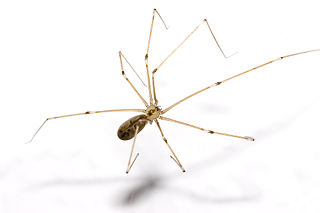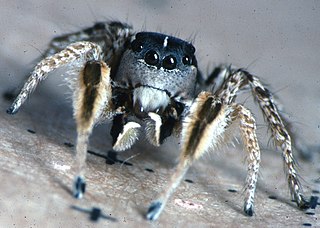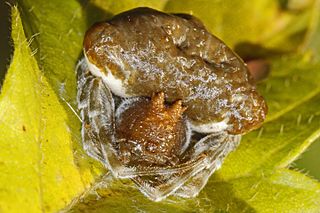
Sammamish is a city in King County, Washington, United States. The population was 67,455 at the 2020 census. Located on a plateau, the city is bordered by Lake Sammamish to the west and the Snoqualmie Valley to the east. Sammamish is situated 20 miles east of Seattle, is a member of the Eastside, and is a part of the Seattle metropolitan area.

Lake Sammamish is a freshwater lake 8 miles (13 km) east of Seattle in King County, Washington, United States. The lake is 7 miles (11 km) long and 1.5 miles (2 km) wide, with a maximum depth of 105 feet (32 m) and a surface area of 8 sq mi (21 km2). It lies east of Lake Washington and west of the Sammamish Plateau, and stretches from Issaquah in the south to Redmond in the north. At Issaquah it is fed by Issaquah Creek, and at Redmond it drains to Lake Washington via the Sammamish River, named after the native people who once lived along its entire length.

Huntsman spiders, members of the family Sparassidae, are known by this name because of their speed and mode of hunting. They are also called giant crab spiders because of their size and appearance. Larger species sometimes are referred to as wood spiders, because of their preference for woody places. In southern Africa the genus Palystes are known as rain spiders or lizard-eating spiders. Commonly, they are confused with baboon spiders from the Mygalomorphae infraorder, which are not closely related.

The Araneomorphae are an infraorder of spiders. They are distinguishable by chelicerae (fangs) that point diagonally forward and cross in a pinching action, in contrast to the Mygalomorphae, where they point straight down. Araneomorphs comprise the vast majority of living spiders.

The Pholcidae are a family of araneomorph spiders. The family contains more than 1,800 individual species of pholcids, including those commonly known as cellar spider, daddy long-legs spider, carpenter spider, daddy long-legger, vibrating spider, gyrating spider, long daddy, and skull spider. The family, first described by Carl Ludwig Koch in 1850, is divided into 94 genera.

Crevice weaver spiders (Filistatidae) comprise cribellate spiders with features that have been regarded as "primitive" for araneomorph spiders. They are weavers of funnel or tube webs. The family contains 18 genera and more than 120 described species worldwide.

Velvet spiders are a small group of spiders almost entirely limited to the Old World, with exception of a few species known from Brazil. In Europe some are commonly called the ladybird spiders

Lake Sammamish State Park is a park at the south end of Lake Sammamish, in King County, Washington, United States. The park, which is administered by the Washington State Park System, covers an area of 512 acres (0.80 sq mi) and has 6,858 feet (2,090 m) of waterfront; Issaquah Creek meets with Lake Sammamish within the park. It is a popular location for boating and watersport activities, such as waterskiing.

Alireza Zamani is an Iranian arachnologist and taxonomist.

Saaristoa is a genus of sheet weavers that was first described by Alfred Frank Millidge in 1978.
Titiotus flavescens is a species of false wolf spiders & wandering spiders in the family Zoropsidae. It is found in the United States.

Habronattus tarsalis is a species of jumping spider in the family Salticidae. It is found in the United States and has been introduced into Hawaii.
Tibellus chamberlini is a species of running crab spider in the family Philodromidae. It is found in the United States and Canada.

Habronattus conjunctus is a species of jumping spider in the family Salticidae. It is found in the United States and Mexico.

Acanthepeira stellata, known generally as the starbellied orbweaver or starbellied spider, is a species of orb weaver in the spider family Araneidae. It is found in a range from Canada to Mexico. It is most commonly found along the Eastern and Western coastline of North America.

Metacyrba punctata is a species of jumping spider. It is found from the southern United States to Ecuador.

Philodromus marxi, the metallic crab spider, is a species of running crab spider in the family Philodromidae. It is found in the United States. They are a sexually dimorphic species. The males are smooth with a metallic sheen and the females present as bristly white and grey.

Mastophora phrynosoma is a species of orb weaver in the spider family Araneidae. It is found in the United States. Like all known species of the genus Mastophora, adult females are bolas spiders, capturing their prey with one or more sticky drops at the end of a single line of silk rather than in a web. Males and juvenile females capture their prey directly with their legs.

Scytodes fusca, the brown spitting spider, is a species of spitting spider in the family Scytodidae. It is found in Central and Southern America, has been introduced into Europe, tropical Africa, Seychelles, Myanmar, China, Japan, and Hawaii.

Phidippus comatus is a species of jumping spider in the family Salticidae. It is found in North America.

















